In today’s fast-paced digital world, businesses are continuously searching for innovative ways to enhance customer engagement and maximise their return on investment (ROI). One of the most effective tools in this quest is digital signage. When implemented correctly, digital signage can significantly boost brand visibility, enhance customer experiences, and drive sales. This comprehensive guide will delve into the best practices for maximising ROI with digital signage, focusing on content creation, placement, technology, and measurement strategies.
1. Understanding Digital Signage ROI

Before diving into best practices, it’s essential to understand how digital signage contributes to ROI. ROI measures the efficiency of an investment. For digital signage, ROI can be evaluated in terms of increased sales, improved customer engagement, enhanced brand awareness, and cost savings from reduced print advertising. The goal is to ensure that the benefits derived from digital signage significantly outweigh the costs involved in its implementation and maintenance.
2. Defining Clear Objectives
To achieve a high ROI, it’s crucial to define clear objectives for your digital signage strategy. Are you looking to increase foot traffic, boost sales, enhance customer experience, or promote new products? Having well-defined goals will guide your content creation and deployment strategies, ensuring that your digital signage efforts align with your overall business objectives.
3. Content is King
Content plays a pivotal role in the effectiveness of digital signage. The right content can capture attention, convey your message, and drive action. Here are some best practices for creating compelling content:
a. Understand Your Audience: Tailor your content to meet the needs and preferences of your target audience. Use customer data and analytics to create personalised and relevant messages.
b. Keep It Simple: Digital signage content should be clear and concise. Use bold headlines, simple graphics, and minimal text to convey your message quickly and effectively.
c. Use High-Quality Visuals: High-resolution images and videos are crucial for creating a professional and engaging appearance. Ensure that all visual content is of high quality and optimised for display on your screens.
d. Leverage Motion Graphics: Motion graphics and animations can grab attention and hold viewer interest. However, use them sparingly to avoid overwhelming your audience.
e. Incorporate Branding: Ensure that your digital signage content aligns with your brand’s identity. Use consistent colours, fonts, and logos to reinforce brand recognition.
f. Rotate Content Regularly: Regularly updating your content keeps it fresh and relevant, preventing viewer fatigue. Rotate promotional messages, product highlights, and informational content to maintain interest.
4. Strategic Placement
The placement of your digital signage is just as important as the content displayed. Proper placement ensures maximum visibility and engagement. Consider the following tips:
a. High Traffic Areas: Position your signage in areas with high foot traffic, such as entrances, waiting areas, and checkout lines. This maximises exposure to a larger audience.
b. Eye Level Positioning: Place screens at eye level to ensure they are easily visible. For standing audiences, this typically means around 5-6 feet from the ground.
c. Contextual Relevance: Place signage where it’s most relevant to the audience. For example, promotional messages for a sale can be placed near the product in question.
d. Avoid Glare: Ensure screens are positioned to avoid glare from windows or overhead lights, which can make content difficult to read.
e. Interactive Zones: Create interactive zones where customers can engage directly with the content. This could include touch screens or kiosks that provide additional information or services.
5. Leveraging Advanced Technologies
Incorporating advanced technologies can enhance the effectiveness of your digital signage and boost ROI. Here are some key technologies to consider:
a. Interactive Touchscreens: Touchscreens allow customers to interact directly with the signage, providing a more engaging and personalised experience. This can be particularly useful for wayfinding, product information, and self-service applications.
b. AI and Data Analytics: Utilise AI and data analytics to track viewer engagement, measure the effectiveness of your content, and gain insights into customer behaviour. This data can help you refine your content strategy and improve ROI.
c. Dynamic Content Management Systems (CMS): A robust CMS allows you to easily update and manage your content across multiple screens. Look for a CMS that supports scheduling, remote management, and real-time updates.
d. Integration with Other Systems: Integrate your digital signage with other business systems, such as inventory management or customer relationship management (CRM) systems. This allows for real-time updates and more personalised content.
6. Measuring Success

To maximise ROI, it’s essential to measure the success of your digital signage efforts. Here are some key metrics to track:
a. Audience Metrics: Track the number of viewers, their demographics, and engagement levels. Tools like camera analytics and sensors can provide valuable insights.
b. Content Performance: Measure the effectiveness of different types of content. Track metrics such as click-through rates, dwell time, and interactions.
c. Sales Impact: Analyse the impact of digital signage on sales. Compare sales data before and after implementing digital signage to assess its effectiveness.
d. Customer Feedback: Gather feedback from customers to understand their perception of your digital signage. Use surveys, focus groups, and social media monitoring to gather insights.
e. ROI Calculation: Calculate the ROI of your digital signage by comparing the total cost of implementation and maintenance to the revenue generated or cost savings achieved.
7. QR Codes and Mobile Integration
One of the most effective ways to enhance the interactivity and ROI of your digital signage is by integrating QR codes and mobile technology. This section will explore how to leverage these tools to maximise engagement and drive results.
a. Enhancing Engagement with QR Codes
QR codes are a simple yet powerful tool for bridging the gap between physical and digital experiences. Here’s how to effectively use QR codes in your digital signage strategy:
- Direct Traffic to Online Resources: Use QR codes to direct viewers to your website, social media profiles, or specific landing pages. This can drive online traffic and increase conversions.
- Provide Additional Information: QR codes can link to product details, customer reviews, and instructional videos, providing customers with more information at their fingertips.
- Facilitate Mobile Payments: Integrate QR codes with mobile payment systems to offer a seamless checkout experience. This can be particularly useful in retail environments.
- Offer Promotions and Discounts: Use QR codes to distribute exclusive offers, discounts, or coupons. This can incentivize purchases and increase sales.
- Track Engagement: QR codes can be tracked, allowing you to measure how many people scan them and what actions they take afterward. This data can provide valuable insights into customer behaviour and campaign effectiveness.
To create and manage your QR codes efficiently, consider using a QR code generator.
b. Mobile Integration for a Seamless Experience
Integrating mobile technology with your digital signage can create a seamless and immersive customer experience. Here are some ways to achieve this:
- Mobile Apps: Develop mobile apps that interact with your digital signage. For example, users can scan a QR code on the signage to access an app with additional features, such as product search, personalised recommendations, and loyalty programs.
- Beacons and Geofencing: Use beacons and geofencing to send personalised notifications and offers to customers’ smartphones when they are near your digital signage. This can drive foot traffic and increase engagement.
- Augmented Reality (AR): Incorporate AR elements into your digital signage to create interactive and immersive experiences. Customers can use their smartphones to interact with AR content, such as virtual try-ons or 3D product displays.
- Social Media Integration: Encourage customers to share their experiences on social media by integrating social media feeds and hashtags into your digital signage. This can increase brand visibility and drive online engagement.
8. Future Trends in Digital Signage
As technology continues to evolve, new trends are emerging that will shape the future of digital signage. Here are some trends to watch:
a. AI and Machine Learning: AI and machine learning will enable more personalised and dynamic content. Digital signage will be able to adapt in real-time based on viewer demographics, behaviour, and preferences.
b. 5G Connectivity: The rollout of 5G networks will enable faster and more reliable connections for digital signage, allowing for real-time updates and richer content experiences.
c. Sustainable Signage: There will be a growing focus on sustainability, with energy-efficient displays and eco-friendly materials becoming more prevalent.
d. Enhanced Interactivity: Touchless interactions, gesture controls, and voice commands will become more common, providing safer and more intuitive user experiences.
e. Integration with IoT: Digital signage will increasingly integrate with Internet of Things (IoT) devices, allowing for smarter and more responsive displays that can interact with the environment and other connected devices.
Conclusion
Digital signage offers immense potential for enhancing customer engagement, driving sales, and maximising ROI. By following the best practices outlined in this guide, businesses can create compelling content, strategically place their signage, leverage advanced technologies, and effectively measure success. Integrating QR codes and mobile technology can further enhance interactivity and provide a seamless customer experience. As technology continues to evolve, staying ahead of trends and continuously refining your digital signage strategy will ensure sustained success and a higher return on investment.
Don’t miss the latest news and updates visit: Discover Tribune!




